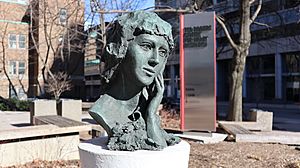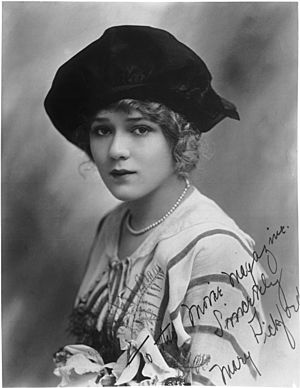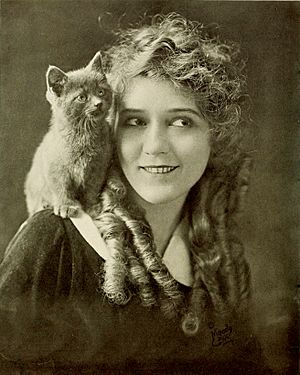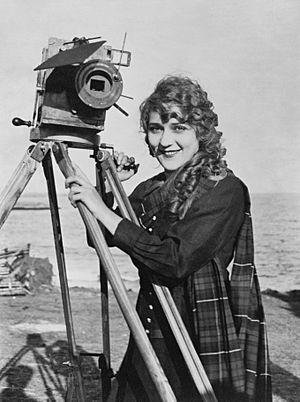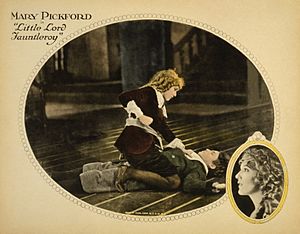Mary Pickford facts for kids
Quick facts for kids
Mary Pickford
|
|
|---|---|
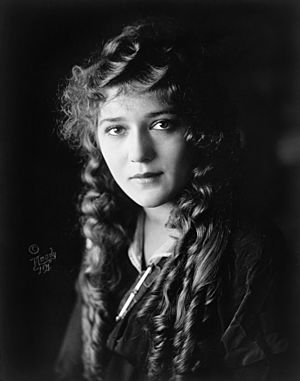
Pickford in 1910
|
|
| Born |
Gladys Marie Smith
April 8, 1892 |
| Died | May 29, 1979 (aged 87) Santa Monica, California, U.S.
|
| Burial place | Forest Lawn Memorial Park, Glendale, California |
| Citizenship | British subject (1892–1920) United States (1920–1979) Canada (1978–1979) |
| Occupation |
|
| Years active | 1900–1955 |
| Spouse(s) |
|
| Children | 2 |
| Parent(s) |
|
| Relatives |
|
| Signature | |
 |
|
Gladys Marie Smith (born April 8, 1892 – died May 29, 1979), known professionally as Mary Pickford, was a Canadian-American actress and producer. Her career lasted for five decades. She was a pioneer in the US film industry, meaning she helped start and shape it. Mary Pickford helped create famous film companies like Pickford–Fairbanks Studios and United Artists. She was also one of the 36 people who started the Academy of Motion Picture Arts and Sciences, which gives out the Academy Awards (Oscars). Pickford is considered one of the most famous women in history.
During the silent film era, she was called "America's Sweetheart" and "the girl with the curls". She is listed as the 24th top female star from the Classical Hollywood Cinema era. Pickford was one of the Canadian pioneers in early Hollywood and was very important in how movie acting developed. She was one of the first stars to have her name shown in movie credits. She was one of the most popular actresses in the 1910s and 1920s, earning the nickname "Queen of the Movies". She became known for playing innocent, charming young women in movies.
Mary Pickford won the second Academy Award for Best Actress for her first movie with sound, Coquette (1929). By the late 1920s, her career slowed down. She received a special Academy Honorary Award in 1976 for all her amazing work in American movies.
Contents
Early Life of Mary Pickford
Mary Pickford was born Gladys Marie Smith in 1892 in Toronto, Ontario, Canada. Her father, John Charles Smith, worked many different jobs. Her mother, Charlotte Hennessey, was a seamstress. Mary had two younger siblings, Lottie Pickford and Jack Pickford, who also became actors.
When Gladys was seven, her family was struggling. A theatrical stage manager suggested that Gladys and Lottie try acting. Gladys got two small roles, and Lottie had a silent part in a play called The Silver King. Their mother played the organ. Pickford then acted in many plays in Toronto. She even played the main child role in Uncle Tom's Cabin.
Mary Pickford's Career
Starting Out in Film
By the early 1900s, acting became a family business. Gladys, her mother, and her two younger siblings traveled across the United States by train, performing in plays. After six years, Gladys decided to try for a main role on Broadway. If she failed, she planned to quit acting. In 1907, Gladys got a supporting role in a Broadway play called The Warrens of Virginia. The play's producer, David Belasco, told Gladys Smith to use the stage name Mary Pickford.
On April 19, 1909, director D. W. Griffith from the Biograph Company gave her a screen test for a film. She didn't get that role, but Griffith was very impressed. She quickly understood that movie acting was simpler than the fancy stage acting of the time. Most Biograph actors earned $5 a day, but Griffith agreed to pay Pickford $10 a day, guaranteeing her $40 a week.
Pickford played many different roles at Biograph, including mothers, young innocent women, and strong characters. In 1909, she appeared in 51 films, almost one a week. Her first main role was in The Violin Maker of Cremona with her future husband, Owen Moore.
In January 1910, Pickford went with a Biograph film crew to Los Angeles. Many film companies moved to the West Coast for the winter because of better light and longer days.
At Griffith's company, actors were not listed in the movie credits. But audiences quickly noticed and recognized Pickford. Movie theaters started advertising films featuring "The Girl with the Golden Curls" or "The Biograph Girl" to attract viewers.
Pickford left Biograph in December 1910. The next year, she starred in films for Carl Laemmle's IMP Company. She wasn't happy with their creative quality, so she returned to work with Griffith in 1912. Some of her best performances were in his films, like Friends and The Female of the Species. Pickford made her last Biograph movie, The New York Hat, in late 1912.
She returned to Broadway in 1912 but realized how much she missed film acting. In 1913, she decided to work only in movies. That year, Adolph Zukor started Famous Players in Famous Plays, which later became Paramount Pictures.
Pickford joined Zukor's company. Zukor first filmed Pickford in a silent version of A Good Little Devil. This film was not very good, and Pickford called it "one of the worst I ever made".
However, Pickford's work in films made just for the camera had gained many fans. Comedy-dramas like In the Bishop's Carriage (1913) and Caprice (1913) made her very popular. Hearts Adrift (1914) was so popular that Pickford asked for a pay raise. This film was the first time Pickford's name was shown above the title on movie posters. Tess of the Storm Country was released five weeks later. This film "sent her career into orbit and made her the most popular actress in America, if not the world."
Her popularity was described in 1916 as "luminous tenderness in a steel band of gutter ferocity." Only Charlie Chaplin was slightly more popular than Pickford in 1916. Both were much more famous than other actors. Throughout the 1910s and 1920s, Pickford was thought to be the most famous woman in the world.
Becoming a Star
Mary Pickford starred in 52 feature films during her career. On June 24, 1916, Pickford signed a new contract. It gave her full control over making the films she starred in. She also got a record-breaking salary of $10,000 a week. Plus, Pickford received half of a film's profits, with a guarantee of $1,040,000. This made her the first actress to sign a million-dollar contract. She also became vice-president of Pickford Film Corporation.
Sometimes, she played a child in films like The Poor Little Rich Girl (1917) and Pollyanna (1920). Pickford's fans loved these "little girl" roles. Because she was small (under five feet tall) and a natural actress, she was very successful in these parts.
In August 1918, Pickford's contract ended. She was offered $250,000 to leave the movie business, but she said no. She went to First National Pictures, which agreed to her terms. In 1919, Pickford, along with D. W. Griffith, Charlie Chaplin, and Douglas Fairbanks, started their own film company called United Artists. Through United Artists, Pickford continued to produce and act in her own movies. She could also choose how to distribute them. In 1920, Pickford's film Pollyanna made about $1,100,000. The next year, Little Lord Fauntleroy was also a hit. In 1923, Rosita made over $1,000,000. During this time, she also made Little Annie Rooney (1925), where she played a child again.
The arrival of sound in movies was a challenge for her. Pickford did not think adding sound to movies was a good idea. She said it would be "like putting lipstick on the Venus de Milo".
She played a wild socialite in Coquette (1929), her first talkie (movie with sound). For this role, her famous ringlets (curly hair) were cut into a short 1920s' bob. Pickford had already cut her hair after her mother died in 1928. Fans were shocked by the change. Pickford's hair had become a symbol of female goodness, and when she cut it, it made front-page news. Coquette was a success, and she won an Academy Award for Best Actress for it. However, the public did not like her as much in more grown-up roles. Like most silent movie stars, Pickford found her career fading as talkies became more popular.
Her next film, The Taming of The Shrew, made with her husband Douglas Fairbanks, did not do well. Many Hollywood actors were worried about talkies. On March 29, 1928, a radio show was broadcast from Pickford's home. Fairbanks, Chaplin, and other stars spoke on the radio to show they could handle talking movies.
Pickford was in her late 30s and could no longer play the children or young women her fans loved. She was also not suited for the glamorous heroines of early sound films. In 1933, she retired from acting after three movies that did not do well. Her last film was Secrets. She appeared on stage in Chicago in 1934 and went on tour in 1935. She also appeared in radio plays in 1935 and 1936. In 1936, she became vice-president of United Artists and continued to produce films for others.
Impact on the Film Industry
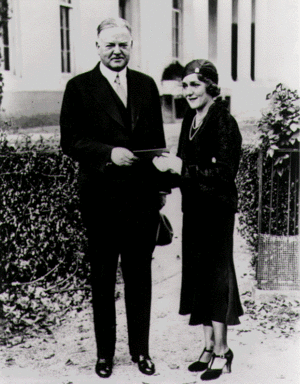
Mary Pickford used her important position in the movie industry to support many causes. Even though her image was delicate and innocent, she was a strong businesswoman. She took control of her career in a very competitive industry.
During World War I, she helped sell Liberty Bonds, which were loans to the government to help pay for the war. She gave many speeches to raise money. She started in Washington, D.C., selling bonds with Charlie Chaplin and Douglas Fairbanks. Five days later, she spoke on Wall Street to about 50,000 people. Even though she was Canadian-born, she was a strong symbol of American culture. She kissed the American flag for cameras and even sold one of her famous curls for $15,000. In one speech in Chicago, she sold about five million dollars' worth of bonds. The U.S. Navy called her their official "Little Sister," and the Army named two cannons after her.

In 1916, Pickford helped start the Hollywood Studio Club. This was a place for young women working in the movie business to live. After World War I, Pickford came up with the idea for the Motion Picture & Television Fund. This organization helps actors who need money. Money left over from her work selling Liberty Bonds helped start it. In 1921, the Motion Picture Relief Fund (MPRF) was officially created. In 1932, Pickford started the "Payroll Pledge Program." This plan allowed studio workers to give a small part of their earnings to the MPRF. Because of this, in 1940, the Fund was able to buy land and build the Motion Picture & Television Country House and Hospital in Woodland Hills, California.
Pickford was a smart businesswoman. She became her own producer within three years of starting in feature films. She managed every part of making her movies, from hiring people to overseeing the script, filming, editing, and promoting each project. She demanded (and received) these powers in 1916.
In 1919, she became even more powerful by co-founding United Artists (UA) with Charlie Chaplin, D. W. Griffith, and Douglas Fairbanks. Before UA, Hollywood studios controlled everything. They produced films and owned movie theaters. Filmmakers had to rely on the studios for their movies to be shown.
United Artists changed this. It was only a distribution company. It offered independent film producers a way to show their movies in its own theaters or in other cinemas. Pickford and Fairbanks made their films after 1920 at their shared studio on Santa Monica Boulevard. Producers who signed with UA had more control over their work than ever before. As a co-founder, producer, and star of her own films, Pickford became the most powerful woman in Hollywood. By 1930, Pickford's acting career had mostly ended. After retiring three years later, she continued to produce films for United Artists. She and Chaplin remained partners in the company for many years. Chaplin left in 1955, and Pickford followed in 1956, selling her shares for $3 million.
She had bought the rights to many of her early silent films. She planned to burn them when she died. But in 1970, she agreed to give 50 of her Biograph films to the American Film Institute. In 1976, she received a special Academy Honorary Award for her contributions to American film.
Mary Pickford's Personal Life
Pickford was married three times. She married Owen Moore, a silent film actor, on January 7, 1911.
Pickford secretly started a relationship with Douglas Fairbanks. They toured the U.S. together in 1918 to help sell Liberty Bonds during World War I. Pickford divorced Moore on March 2, 1920. She married Fairbanks just days later on March 28, 1920. Their wedding was called the "marriage of the century," and they were known as the King and Queen of Hollywood. They went to Europe for their honeymoon, and fans in London and Paris caused crowds trying to see them. When they returned to Hollywood, huge crowds greeted them at railway stations across the United States.
Fairbanks became known for heroic roles. Pickford continued to play the good but spirited "girl next door." Even at private parties, people would stand up when Pickford entered a room. She and her husband were often called "Hollywood royalty." Their fame was worldwide. Leaders from other countries who visited the White House often asked if they could also visit Pickfair, the couple's mansion in Beverly Hills.
Dinners at Pickfair were big celebrity events. Charlie Chaplin, Fairbanks' best friend, was often there. Other guests included famous people like Albert Einstein and Helen Keller. However, their public life put a strain on their marriage. Both she and Fairbanks had little time off from making movies. They were also constantly seen as America's unofficial representatives to the world. When their film careers slowed down, Fairbanks traveled overseas, which Pickford did not enjoy. When Fairbanks' relationship with another woman became public, he and Pickford separated. They divorced on January 10, 1936.
On June 24, 1937, Pickford married her third and last husband, actor and band leader Charles "Buddy" Rogers. They adopted two children: Roxanne and Ronald Charles. Pickford's relationship with her adopted children was sometimes tense.
Later Years and Death
Mary Pickford's mother died in March 1928. Her siblings, Lottie and Jack, both died in 1936 and 1933. These deaths, her divorce from Fairbanks, and the end of silent films made Pickford very sad. She gradually became a recluse, staying mostly at Pickfair. Only a few close friends and family members visited her.
In 1955, she published her memories in a book called Sunshine and Shadows. She had also published essays on spirituality and a novel.
In the mid-1960s, Pickford often only spoke to visitors by phone from her bedroom. Charles "Buddy" Rogers often gave guests tours of Pickfair. When Pickford received an Academy Honorary Award in 1976, the Academy sent a TV crew to her house to record her thank you speech. This gave the public a rare look inside Pickfair Manor. Charitable events continued to be held at Pickfair, including a Christmas party for blind war veterans.
Mary Pickford believed she stopped being a British citizen when she married Fairbanks, an American, in 1920. However, she always held a British/Canadian passport. Near the end of her life, Pickford arranged to officially become a Canadian citizen because she wanted to "die as a Canadian." Her request was approved.
On May 29, 1979, Pickford died in a Santa Monica, California, hospital from problems after a brain bleed. She was buried in the Forest Lawn Memorial Park cemetery in Glendale, California.
Mary Pickford's Legacy
- Pickford received a star on the Hollywood Walk of Fame at 6280 Hollywood Blvd.
- Her handprints and footprints are displayed at Grauman's Chinese Theatre in Hollywood, California.
- The Pickford Center for Motion Picture Study in Hollywood is named after her.
- The Mary Pickford Theater at the Library of Congress is named in her honor.
- A special drink from the Prohibition era, called a Mary Pickford cocktail, was named after her.
- The Mary Pickford Auditorium at Claremont McKenna College is named in her honor.
- A movie theater in Cathedral City, California, called The Mary Pickford Theatre, opened on May 25, 2001. It has a display with items belonging to Pickford and Buddy Rogers.
- In 2007, the Academy of Motion Picture Arts and Sciences sued to stop the sale of one of Pickford's Oscars.
- A bust (a sculpture of her head and shoulders) and a historical plaque mark her birthplace in Toronto. The plaque was unveiled by her husband Buddy Rogers in 1973.
- In 1993, she received a Golden Palm Star on the Palm Springs Walk of Stars.
- Pickford received a star on Canada's Walk of Fame in Toronto in 1999.
- Pickford was featured on a Canadian postage stamp in 2006.
- From 2011, the Toronto International Film Festival showed a collection of Mary Pickford items.
- In 2011, the Spadina Museum in Toronto staged a musical about her life called Sweetheart: The Mary Pickford Story.
- Since 2013, the Mary Pickford Foundation has supported music programs at Pepperdine University for students learning to create music for silent films.
- In 2013, a copy of an early Pickford film thought to be lost (Their First Misunderstanding) was found. It is being restored by the Library of Congress. This film is special because it was the first time Pickford was credited by name.
- The Google Doodle on April 8, 2017, celebrated Mary Pickford's 125th birthday.
- The Girls in the Picture, a 2018 novel, is a story about the friendship between Mary Pickford and screenwriter Frances Marion.
- In 2019, the Toronto International Film Festival announced the first Mary Pickford Award.
Images for kids
-
Pickford's handprints and footprints at Grauman's Chinese Theatre in Hollywood, California
See also
 In Spanish: Mary Pickford para niños
In Spanish: Mary Pickford para niños


